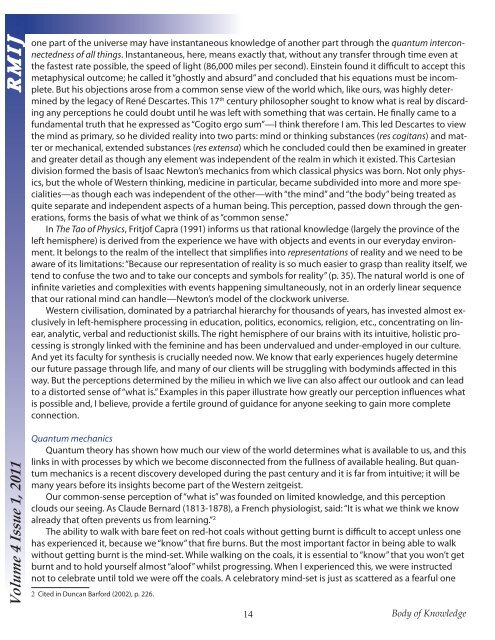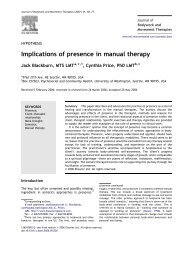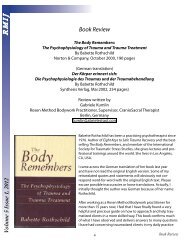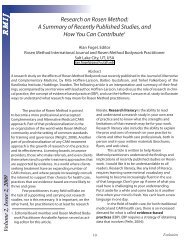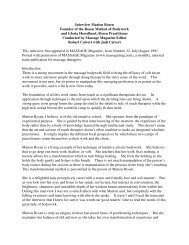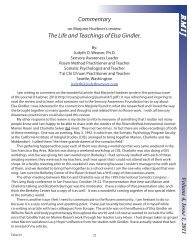R M I J ... Volume 4 Issue 1, 2011 - Rosen Journal
R M I J ... Volume 4 Issue 1, 2011 - Rosen Journal
R M I J ... Volume 4 Issue 1, 2011 - Rosen Journal
Create successful ePaper yourself
Turn your PDF publications into a flip-book with our unique Google optimized e-Paper software.
R M I J . . .<br />
<strong>Volume</strong> 4 <strong>Issue</strong> 1, <strong>2011</strong><br />
one part of the universe may have instantaneous knowledge of another part through the quantum interconnectedness<br />
of all things. Instantaneous, here, means exactly that, without any transfer through time even at<br />
the fastest rate possible, the speed of light (86,000 miles per second). Einstein found it difficult to accept this<br />
metaphysical outcome; he called it “ghostly and absurd” and concluded that his equations must be incomplete.<br />
But his objections arose from a common sense view of the world which, like ours, was highly determined<br />
by the legacy of René Descartes. This 17 th century philosopher sought to know what is real by discarding<br />
any perceptions he could doubt until he was left with something that was certain. He finally came to a<br />
fundamental truth that he expressed as “Cogito ergo sum”—I think therefore I am. This led Descartes to view<br />
the mind as primary, so he divided reality into two parts: mind or thinking substances (res cogitans) and matter<br />
or mechanical, extended substances (res extensa) which he concluded could then be examined in greater<br />
and greater detail as though any element was independent of the realm in which it existed. This Cartesian<br />
division formed the basis of Isaac Newton’s mechanics from which classical physics was born. Not only physics,<br />
but the whole of Western thinking, medicine in particular, became subdivided into more and more specialities—as<br />
though each was independent of the other—with “the mind” and “the body” being treated as<br />
quite separate and independent aspects of a human being. This perception, passed down through the generations,<br />
forms the basis of what we think of as “common sense.”<br />
In The Tao of Physics, Fritjof Capra (1991) informs us that rational knowledge (largely the province of the<br />
left hemisphere) is derived from the experience we have with objects and events in our everyday environment.<br />
It belongs to the realm of the intellect that simplifies into representations of reality and we need to be<br />
aware of its limitations: “Because our representation of reality is so much easier to grasp than reality itself, we<br />
tend to confuse the two and to take our concepts and symbols for reality” (p. 35). The natural world is one of<br />
infinite varieties and complexities with events happening simultaneously, not in an orderly linear sequence<br />
that our rational mind can handle—Newton’s model of the clockwork universe.<br />
Western civilisation, dominated by a patriarchal hierarchy for thousands of years, has invested almost exclusively<br />
in left-hemisphere processing in education, politics, economics, religion, etc., concentrating on linear,<br />
analytic, verbal and reductionist skills. The right hemisphere of our brains with its intuitive, holistic processing<br />
is strongly linked with the feminine and has been undervalued and under-employed in our culture.<br />
And yet its faculty for synthesis is crucially needed now. We know that early experiences hugely determine<br />
our future passage through life, and many of our clients will be struggling with bodyminds affected in this<br />
way. But the perceptions determined by the milieu in which we live can also affect our outlook and can lead<br />
to a distorted sense of “what is.” Examples in this paper illustrate how greatly our perception influences what<br />
is possible and, I believe, provide a fertile ground of guidance for anyone seeking to gain more complete<br />
connection.<br />
Quantum mechanics<br />
Quantum theory has shown how much our view of the world determines what is available to us, and this<br />
links in with processes by which we become disconnected from the fullness of available healing. But quantum<br />
mechanics is a recent discovery developed during the past century and it is far from intuitive; it will be<br />
many years before its insights become part of the Western zeitgeist.<br />
Our common-sense perception of “what is” was founded on limited knowledge, and this perception<br />
clouds our seeing. As Claude Bernard (1813-1878), a French physiologist, said: “It is what we think we know<br />
already that often prevents us from learning.” 2<br />
The ability to walk with bare feet on red-hot coals without getting burnt is difficult to accept unless one<br />
has experienced it, because we “know” that fire burns. But the most important factor in being able to walk<br />
without getting burnt is the mind-set. While walking on the coals, it is essential to “know” that you won’t get<br />
burnt and to hold yourself almost “aloof” whilst progressing. When I experienced this, we were instructed<br />
not to celebrate until told we were off the coals. A celebratory mind-set is just as scattered as a fearful one<br />
2 Cited in Duncan Barford (2002), p. 226.<br />
14<br />
Body of Knowledge


